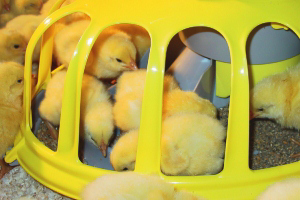Salmonella control on the farm

Effective Salmonella control on the farm is based on preventing the introduction of Salmonella onto a farm and preventing its spread.
Stop Salmonella entering the farm
On arrival at the site, chicks should be Salmonella free. To start with, there must be adequate Salmonella monitoring and control at the hatchery.
When chicks arrive at the site, samples can be taken from chick box liners, swabs from bases of boxes and chicks dead-on-arrival or cull chicks. Culture of these samples will confirm the Salmonella status of the new birds. Positive samples should be traced to the supplier.
Stop the spread of Salmonella on the farm
1 Monitoring
Flocks should be monitored frequently for possible Salmonella infection. Samples for culture can be taken from: litter, faecal samples, boot or drag swabs and dust samples.
On broiler farms, a combination of boot swabs and dust taken at 21-28 days is better than sampling litter.
For breeder flocks in lay and commercial laying flocks, samples can also be taken from: nest-box floor swabs, nest-box litter, swabs from egg sorting tables and corridors and spilled debris from the egg-collection belt.
In cases of positive samples, appropriate action must be taken. This could be:
– treatment with antimicrobials
– Culling. In many countries the slaughter of positive breeding flocks is mandatory. Compensation is paid.
– Informing the hatchery, slaughterhouse or egg distributors/processing plant.
2 Vaccination
Breeders, broilers and layers can all be vaccinated against Salmonella. For more detail, see the appropriate vaccine and vaccination scheme for each group.
3 Gut-flora enhancement
The inclusion of so-called “competitive exclusion products” in the diet of broilers on the farm results in extra protection against Salmonella infection as the maternal antibodies decline. These products support the natural intestinal microflora resulting on a negative effect on pathogenic bacteria such as Salmonella. The shedding of Salmonella is thus reduced.
4 Cleaning and disinfection
Houses and buildings should be designed to facilitate cleaning and disinfection. After cleaning swabs should be taken to check for the persistence of Salmonella. Farms that may pose problems are large multiple house sites with a short turnaround time. These farms may not allow adequate time for efficient cleaning and disinfection. Problem farms (farms with previous Salmonella positive flocks) should allow more time for cleaning and disinfection.
In general the following rules count:
– Wash – dry – disinfect – dry – fog
– Drying is very important in the complete elimination of Salmonella
– Effective disinfectants/application rate/concentration
– Avoid recontamination – staff/equipment/pests
After cleaning and disinfection, fresh litter should be supplied for each new flock.
5 Hatching egg hygiene
This is another important aspect of on farm Salmonella control. Chicks may be infected with Salmonella via contaminated egg-shells. This could cause the spread of Salmonellosis in the hatchery. Shells are usually contaminated in nest boxes by faeces. Strict attention should be paid to the management of nest boxes.
– Eggs should be collected at least 3x daily
– Dirty eggs and eggs taken from the floor should be separated and not used for hatching
– Lightly soiled eggs may be cleaned by gentle buffing or with a bactericidal solution. In the hatchery these eggs should be placed at the bottom of the setters and hatcher
Source: Merck Animal Health









